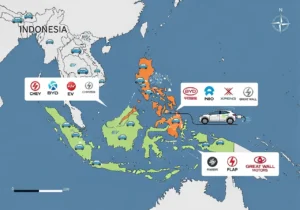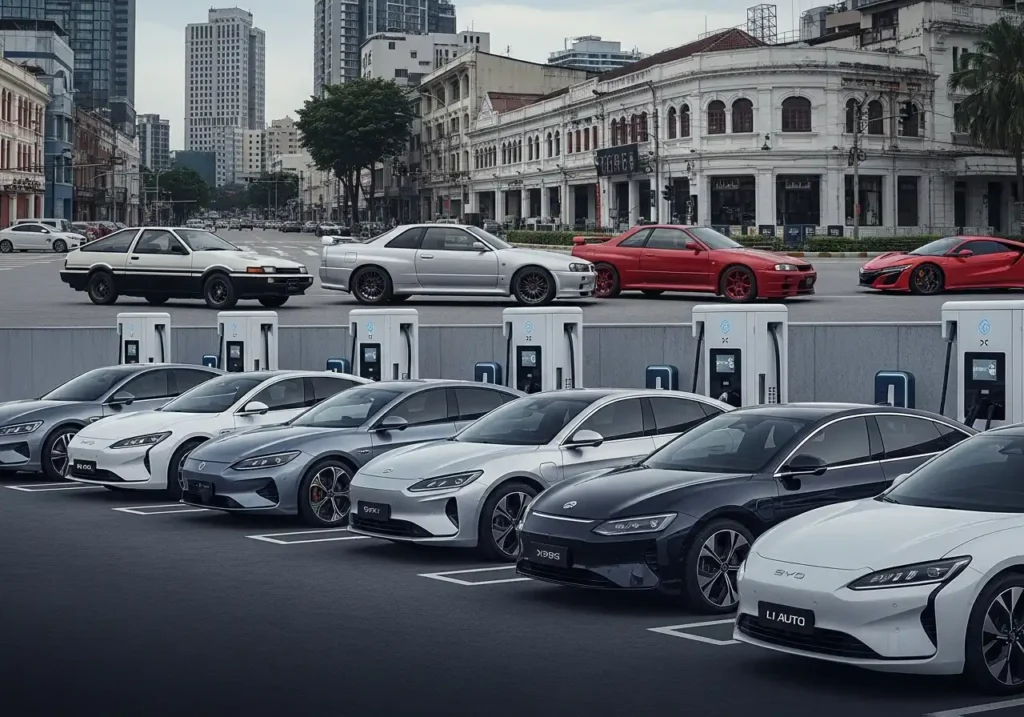The automotive landscape in Southeast Asia is undergoing a significant transformation. Traditional Japanese automakers, who have long dominated the region’s car sales, are now facing stiff competition from Chinese electric vehicle (EV) manufacturers. This shift is not just a trend but a clear indication of the evolving dynamics in the global automotive industry. As governments ramp up environmental policies, the push for electric mobility is changing the landscape rapidly, and Chinese brands are seizing the opportunity.
The Rise of Chinese EVs in Southeast Asia
 In recent years, Chinese EV brands have made substantial inroads into Southeast Asia’s automotive market. Companies like BYD, Geely, and Seres are expanding their presence through strategic partnerships, local manufacturing, and competitive pricing strategies. For instance, BYD has become a significant player in Indonesia, offering models like the Atto 3 at prices significantly lower than their Japanese counterparts. This aggressive expansion is not limited to the larger markets like Indonesia and Thailand but is also reaching smaller markets like the Philippines and Vietnam.
In recent years, Chinese EV brands have made substantial inroads into Southeast Asia’s automotive market. Companies like BYD, Geely, and Seres are expanding their presence through strategic partnerships, local manufacturing, and competitive pricing strategies. For instance, BYD has become a significant player in Indonesia, offering models like the Atto 3 at prices significantly lower than their Japanese counterparts. This aggressive expansion is not limited to the larger markets like Indonesia and Thailand but is also reaching smaller markets like the Philippines and Vietnam.
What makes these Chinese EVs even more appealing is the combination of cutting-edge technology and affordability. Chinese manufacturers are known for incorporating advanced features, such as intelligent in-car systems, efficient battery technology, and autonomous driving capabilities—all at a price point that often undercuts traditional internal combustion engine (ICE) vehicles, including their Japanese competitors.
Factors Driving the Shift
- Government Incentives: Many Southeast Asian governments are offering subsidies and tax breaks to promote EV adoption, making Chinese EVs more attractive to consumers. For example, Indonesia, one of the largest automotive markets in the region, introduced tax incentives for electric cars and EV production, which has helped lower the entry cost for Chinese manufacturers like BYD and Great Wall Motors.
- Competitive Pricing: Chinese manufacturers can leverage economies of scale and local production to offer affordable EV options. The production of EVs within Southeast Asia not only reduces shipping costs but also helps circumvent import tariffs, enabling Chinese companies to price their vehicles aggressively.
- Advanced Technology: Chinese EVs often come equipped with the latest technology, including advanced infotainment systems and autonomous driving features. For instance, models like the BYD Atto 3 offer Level 2 autonomous driving capabilities, which is a major draw for consumers who are looking for futuristic features in their vehicles.
- Environmental Policies: With climate change becoming an increasing concern, governments in Southeast Asia are placing more emphasis on reducing carbon emissions. Electric vehicles are seen as an essential part of the region’s environmental strategy, prompting local governments to further support the transition to EVs through subsidies and policy support. Chinese manufacturers are well-positioned to take advantage of these favorable conditions.
Challenges for Japanese Automakers
Japanese automakers, traditionally dominant in the region, are now facing challenges in maintaining their market share. The rise of Chinese EVs has led to a decline in sales for brands like Toyota and Honda. These companies have long had a stronghold on Southeast Asia’s automotive market due to their reputation for reliability and affordable prices. However, as consumer preferences shift towards EVs, Japanese brands are struggling to keep up with the rapid pace of electric vehicle development.
To counter the growing presence of Chinese EVs, Japanese automakers are pivoting towards hybrid technology, which allows for a gradual transition to fully electric vehicles. Toyota, for example, has heavily invested in hybrid models like the Toyota Prius and the Toyota Corolla Cross Hybrid. However, as governments impose stricter emissions regulations, many experts believe that Japanese automakers must accelerate their efforts in EV development if they wish to remain competitive in the region.
The Role of Southeast Asia’s Consumer Preferences
 Consumer behavior in Southeast Asia is another critical factor driving the success of Chinese EVs. As disposable incomes increase and middle-class populations expand, more consumers are seeking vehicles that offer value for money, along with the benefits of modern technology. The younger generation, in particular, is drawn to the environmental benefits of electric vehicles and the cutting-edge technology that comes with them. This demographic is not only more environmentally conscious but also more inclined to embrace new technology, making them prime targets for Chinese EV manufacturers.
Consumer behavior in Southeast Asia is another critical factor driving the success of Chinese EVs. As disposable incomes increase and middle-class populations expand, more consumers are seeking vehicles that offer value for money, along with the benefits of modern technology. The younger generation, in particular, is drawn to the environmental benefits of electric vehicles and the cutting-edge technology that comes with them. This demographic is not only more environmentally conscious but also more inclined to embrace new technology, making them prime targets for Chinese EV manufacturers.
Moreover, as the region’s urban population grows, there is an increasing demand for efficient, environmentally friendly transport solutions. The typical urban consumer is looking for vehicles that are not only cost-effective but also sustainable in the long term. With the cost of electric vehicle batteries dropping, Chinese manufacturers can offer EVs at more affordable prices, making them an attractive option for this growing market segment.
The Future Outlook
The competition between Chinese and Japanese automakers is expected to intensify in the coming years. As consumer preferences shift towards electric mobility and governments continue to support EV adoption, Chinese EV manufacturers are well-positioned to expand their market share in Southeast Asia. With the support of strategic government incentives, growing domestic production, and continuous innovation in battery technology and vehicle design, Chinese automakers are set to play a pivotal role in the future of Southeast Asia’s automotive market.
In addition, other players like VinFast from Vietnam are entering the market with their own electric vehicle offerings, further increasing the competition and offering consumers more choices. This competitive landscape will likely lead to faster adoption of electric vehicles across the region, benefiting not just the manufacturers but also consumers, who will enjoy lower prices and better technology.
